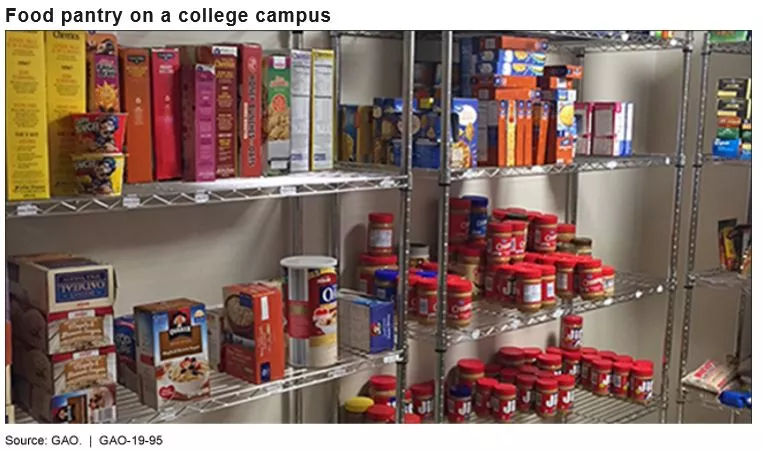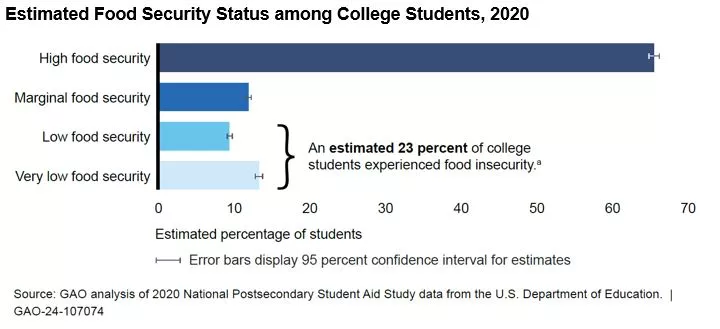Fighting Food Insecurity Occurs at All Ages—But Two Populations May Get Overlooked
Food insecurity doesn’t discriminate by age. Millions of Americans—from college students to senior citizens—lack access to adequate, nutritious foods every year.
During the COVID-19 pandemic, some food assistance programs changed their operations and requirements to help meet the moment. Such changes included federal assistance for college students and older adults.
Today’s WatchBlog post looks at our recent reports on food insecurity among college students and older adults, and how COVID changed the programs they rely on.
Image

Food insecurity among college students can have long-lasting impacts
Students may receive financial assistance to pay for the cost of college, including living expenses such as food and housing, while enrolled. Indeed, the federal government spends billions each year on grants, loans, and work-study funding to help make college more affordable. Yet, many students still cannot afford basic necessities like food.
About 3.8 million college students reported experiencing food insecurity in 2020. A majority of these students reported eating less than they should or skipping meals because they couldn’t afford enough food.
Image

Beyond the impacts to their health, food insecurity—and the hunger that may result—can negatively affect students’ academic success. Studies have found that students who experience food insecurity are more likely to have lower grades and are less likely to graduate compared to their peers. Some may even drop out altogether because of limited or uncertain access to food.
Some of these students may qualify for food assistance under SNAP—the Supplemental Nutritional Assistance Program benefits, which used to be known as “food stamps.” SNAP is the nation’s largest such program for low-income households.
We analyzed Department of Education data and estimated that fewer than 2 in 5 food insecure students would have met the requirements needed to be eligible for SNAP had they applied. Of these students, most (59%) didn’t report receiving SNAP benefits in 2020.
Some of the SNAP requirements for college students include working while in school or being a single parent, among other things.
What impact did the pandemic have on college students’ access to SNAP?
During COVID-19, Congress temporarily expanded SNAP eligibility to certain students:
- Those who were eligible to participate in state or federally funded work-study during the regular academic year, as determined by their college, and
- Those who had an Expected Family Contribution of $0 during the academic year on their FAFSA federal aid application—including students who were eligible for a maximum Pell Grant award.
We estimated that extending eligibility to students who had an Expected Family Contribution of $0 expanded SNAP eligibility to an additional 1 million students in 2020. This resulted in an estimated 4.4 million total students being potentially eligible for benefits. These temporary expansions expired in June 2023, following the end of the public health emergency.
Our new report is the first of two about college students and food insecurity.
Older adults facing food insecurity may also struggle accessing available services
Recent data shows that approximately 18% of older adults in the U.S. experience food insecurity. Lack of mobility can further impact older adults’ access to food. Seniors with mobility limitations are particularly vulnerable to isolation and may not be able to access food programs that require them to drive to pantries or other locations. They also may not be able to travel to grocery stores.
During the pandemic, many nonprofits and public pantries stood up programs to deliver meals to older adults in need. Indeed, there was a slight increase in the number of seniors who received home-delivery meals during that time. The shift to home delivered meals was part of an effort to continue providing services while not spreading COVID or putting vulnerable seniors at risk of COVID’s health effects.
But since the pandemic’s state of emergency ended, there may have been a reduction in the overall number of meals provided to seniors. This could potentially reduce seniors’ access to the food assistance they had during the pandemic.
You can learn more about this issue by reading our June report.
- GAO’s fact-based, nonpartisan information helps Congress and federal agencies improve government. The WatchBlog lets us contextualize GAO’s work a little more for the public. Check out more of our posts at GAO.gov/blog.
GAO Contacts
Related Products

GAO's mission is to provide Congress with fact-based, nonpartisan information that can help improve federal government performance and ensure accountability for the benefit of the American people. GAO launched its WatchBlog in January, 2014, as part of its continuing effort to reach its audiences—Congress and the American people—where they are currently looking for information.
The blog format allows GAO to provide a little more context about its work than it can offer on its other social media platforms. Posts will tie GAO work to current events and the news; show how GAO’s work is affecting agencies or legislation; highlight reports, testimonies, and issue areas where GAO does work; and provide information about GAO itself, among other things.
Please send any feedback on GAO's WatchBlog to blog@gao.gov.




